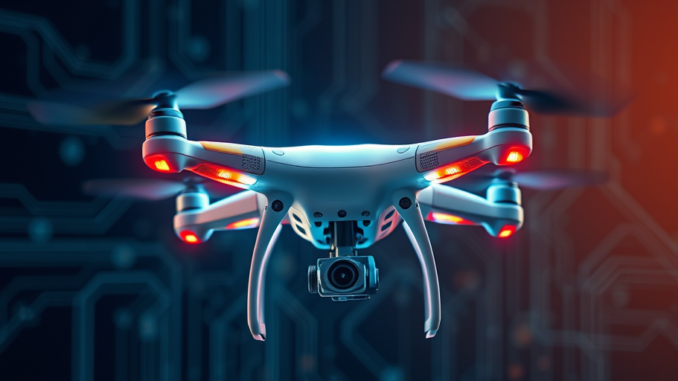
Summary
Researchers have achieved a breakthrough in brain-computer interface (BCI) technology, enabling a person with paralysis to control a virtual drone using only their thoughts. Utilizing Blackrock Neurotech’s microelectrode arrays, the system translates imagined finger movements into complex drone maneuvers with unprecedented precision. This innovation holds immense promise for restoring independence and improving the quality of life for individuals with paralysis.
TrueNAS: the healthcare storage solution thats secure, scalable, and surprisingly affordable.
Main Story
Okay, so, you know how we’ve been talking about brain-computer interfaces (BCIs)? Well, get this: researchers have just made a huge leap. I’m talking about giving people with paralysis the power to fly a virtual drone just by thinking about it. Yes, you read that right—just by thinking about it.
This isn’t some far-off sci-fi dream. A team from Stanford and Michigan actually did it. They used some seriously impressive tech from Blackrock Neurotech, their 96-channel microelectrode array to be exact. It’s a massive step forward, no doubt, for restoring movement and, honestly, improving lives.
Published in Nature, their study details this high-performance BCI, a system able to understand both vertical and horizontal movements across different finger groupings – the thumb, the index and middle, and then the ring and pinky. Think about it. It’s kind of mind-blowing. This fine-tuned control, it’s a four-degree-of-freedom system, has doubled what previous ones could do. And it’s six times better than traditional EEG methods. That’s impressive. In fact, during a trial, a participant managed to hit 76 targets a minute, with 100% accuracy. Can you even imagine? The way the system works, it seems, is pretty intuitive. This participant, who they’ve called T5, just imagined moving his fingers and was able to fly a quadcopter. Seemed like child’s play to him.
What’s really the magic? It’s how accurately the system reads neural signals from the motor cortex, that part of the brain responsible for voluntary movement. When T5 thought about wiggling his fingers, the BCI would decode those signals. It then translated them into commands that controlled the drone, think velocity, direction, that kind of thing. They call it a “human-centered” design, and honestly, it feels like they’ve restored finger movement in this virtual world. That opens the door to real-world possibilities, don’t you think?
And it doesn’t stop at drone control. This could be a game-changer for restoring fine motor skills needed for typing or playing music. Imagine being able to operate complex software or to engage in remote work; these are things many of us take for granted. As a result, it could lead to increased independence, better social connection, more recreational opportunities… for people with paralysis, it’s a big deal.
Of course, there are still challenges. The researchers are working hard on improving the algorithms, especially for “closed-loop training.” This means using feedback from the BCI to make it more accurate over time. Then there’s the issue of creating accurate training data for individuals who can’t move. That’s a pretty complex area to navigate, and it’s important they get it right. Having multiple fingers to decode complicates things further. The system needs to learn all those little subtle neural differences. Still, it’s exciting to see how far they’ve come.
BCIs, if you think about it, have been something we’ve been exploring for years. We’ve seen applications ranging from assistive tech to gaming and ways to be more productive. The fact that BCIs could basically bypass the traditional keyboards or touchscreens – that’s transformative. Blackrock Neurotech’s NeuroPort Array has been in use since 2004, and they’ve been able to help people regain touch, control prosthetics, and interact with digital devices, all despite paralysis or other neurological problems.
This research, honestly, it demonstrates the unbelievable potential of BCIs. As this technology gets better, I think, we’re going to see some truly amazing applications that are going to empower individuals with disabilities and absolutely reshape the way we interact with computers. This recent achievement feels like a crucial step towards a future where thought-controlled interfaces are just… well, normal. What do you think?


A mind-controlled drone, you say? So, if I accidentally think “crash!”, will it follow my every subconscious whim? Maybe a safety switch for runaway thoughts is also needed?
That’s a great point about the safety aspect! The system is still in its early stages, but research on “closed-loop training” is ongoing to improve accuracy and potentially filter out unintended thoughts. It will be fascinating to see how these safeguards evolve with the technology.
Editor: MedTechNews.Uk
Thank you to our Sponsor Esdebe – https://esdebe.com
So, this ‘T5’ chap was hitting 76 targets a minute, eh? I wonder if he’d have the same accuracy trying to order a pizza using his brain? The possibilities… and the potential for pineapple-related mishaps!
That’s a fun thought! The precision is definitely impressive, isn’t it? Thinking about ordering a pizza using just your mind highlights how intuitive and precise this system is becoming. It could be a game-changer for all sorts of interactions with technology.
Editor: MedTechNews.Uk
Thank you to our Sponsor Esdebe – https://esdebe.com
The concept of “human-centered” design is particularly interesting, given the potential for this technology to be tailored to individual needs and preferences. The implications for personalized assistive tech are considerable.
I agree, the human-centered design aspect is crucial! Thinking about how this can adapt to individual needs really opens up possibilities for personalized assistive tech. This could truly revolutionize how people interact with technology, creating more intuitive and effective solutions.
Editor: MedTechNews.Uk
Thank you to our Sponsor Esdebe – https://esdebe.com
The article highlights the impressive control achieved with finger movements. Considering the complexity of typing and playing music, what further developments are needed to allow for such intricate BCI applications?